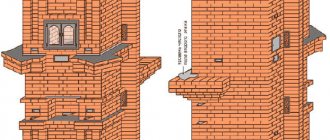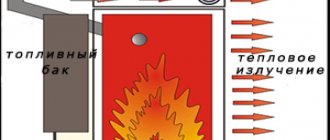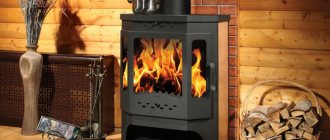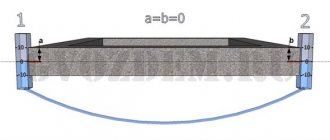Since ancient times, it was believed that the stove in the house was the main property. It doesn’t just heat and makes it possible to cook tasty and healthy food. She is a symbol of comfort, a home that should be preserved and protected. Therefore, skilled stove makers have always been considered a privileged caste. After all, the home nurse had to be built in such a way that it could be quickly and hotly heated, so that in the most severe frost the whole house would be warm and cozy, and the sizzling of the cooking food and the aroma of pies would spread from room to room. But before you start building, you need to calculate the location of the stove in the house. So that not a single molecule of heat is wasted.
What to consider when choosing a location for the stove
Home design
The first and immutable requirement when choosing a furnace location is the complete design of the house. That is, the location of the stove in the house should be planned simultaneously with the walls. In this case, it will not happen that one room will be unbearably hot, and the other will be bitterly cold. And it’s much easier to pour the foundation under it before the floors are laid.
But there are other rules that should be followed.
- Under no circumstances should the foundation for the stove be connected to a common foundation. Over time, the house will definitely shrink and the least that will happen is that the stove will become covered with cracks, from which wisps of smoke will constantly curl, making it impossible and even dangerous to stay in the room. Well, at most it will simply warp and require a lot of repairs.
- The location must be selected in such a way that the chimney is in close proximity to the internal main wall. It will be possible to support the pipe on the ceiling beam.
- Be sure to take into account the layout of the house. Number of rooms and windows. The need to heat the second floor, if there is one. And the material from which the house is built.
- Next, the approximate heat loss of the entire structure is calculated. From here the heat transfer of all surfaces of the stove is calculated.
- The design of the furnace itself must also be thought out in advance.
- Well, one last thing. If the house is too large and one heating device is not enough, you should calculate how many stoves will need to be installed and in what places.
Many years and even centuries of experience show that building too many chimneys means consuming an increased amount of firewood. There is no need to make a separate stove for each room. This is why it is called an ideal location, because with a minimum of space, the largest possible area is heated.
And one more important fact. A stove, no matter what type of fuel it is heated with, is a device around which some amount of garbage, dirt, ash, soot and other dirty substances always accumulate. Therefore, it is better to make the firebox hole in the room that is closest to the front door. Then you won’t have to carry firewood, buckets and bags of ash across the whole house. Believe me, after these voyages the rooms will definitely have to be cleaned.
Where is the Heater Tap on the VAZ 2110
Content
Internal ventilation on a VAZ of the tenth family. supply and exhaust: air is supplied into the cabin through holes in the windshield cover (spontaneously when the car is moving, or forced when the furnace fan is blown. These holes have valves that allow air to pass through, but do not allow it to enter the car. This design improves the thermal insulation of the cabin .
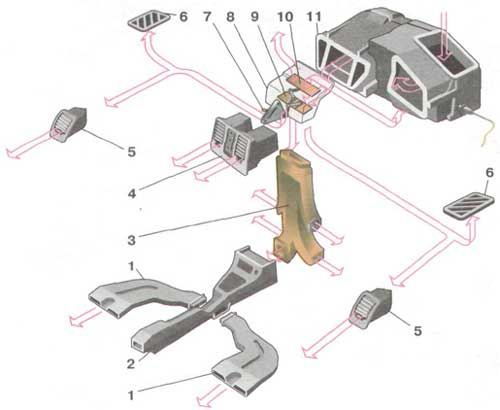
Heating channels and controls: 1. air ducts for heating the rear part of the cabin; 2. lining of the floor tunnel; 3. air ducts for heating the feet; 4. central ventilation of nozzles; 5. ventilation of side nozzles; 6. nozzles for heating the glass of the entrance door; 7. control lever for the internal heating system; 8. air distributor housing; 9. heated feet; 10. windshield heating valve; 11. heater.
The principle of operation of the heater heater on the VAZ 2110 2111 2112
VAZ 2110, 2111, 2112 do not have a heater valve. Cabin temperature is controlled by an air damper, which controls the flow of hot air into the cabin. In the summer, antifreeze enters the plate, which is why some car owners additionally install a tap to turn off the antifreeze supply in the summer. The VAZ-2110 heater control system is automatic, the temperature is maintained exactly up to 2 degrees Celsius. Also, it is better to control the air damper than the valve (it can fly around or get stuck).
The air entering the cabin is heated as needed by passing through the heater core and distributed according to the position of the air flow regulator. Most of the air goes to the windshield and... through deflectors blocked by shock absorbers. to the side windows and to the center of the cabin. Air is also supplied to the feet of the driver and front passenger through two pairs of deflectors (one pair on the knees, the other on the floor) and to the feet of the rear passengers through a cushion to the floor tunnel and two air ducts under the front seats.
The air recirculation system is used to speed up the heating of the cabin and prevent the penetration of outside air (when crossing polluted, smoked, dusty sections of the road). When the recirculation button (on the unit panel) is pressed, the electro-pneumatic valve opens, and under the influence of vacuum on the inlet pipe, the recirculation damper blocks the access of outside air to the passenger compartment. Thus, the operation of the recirculation system is possible only when the engine is running. At the same time, if the fan is turned on, the air in the cabin continues to circulate through the heater ducts.
READ Armrest VAZ 21099 Do It Yourself
The fan has three operating modes: low speed, medium speed and automatic selection (determined by the control unit). Fan motor. collector, direct current, with excitation from permanent magnets. Current consumption at maximum speed. 14 A.
Depending on the selected speed, the engine is connected directly to the vehicle’s on-board network (maximum speed) or through an additional resistor. The latter has two spirals with a resistance of 0.23 Ohm and 0.82 Ohm. If both circuits are included in the circuit, the fan rotates at a low speed if only one (0.23 ohms). in the middle
It is not recommended to press the fan wheel away from the motor shaft. can balance The engine cannot be repaired (except for cleaning the manifold); if it fails, it should be replaced as a fan wheel assembly.
Spare parts for the heater (VAZ 2110 2111 2112): 1. electro-pneumatic valve; 2. heater air heater housing; 3. air absorber water reflector screen; 4. recirculation valve, control valve; 5. air recirculation damper; 6. Rear heater housing with air absorber; 7. duct heater damper; 8. heater control valve; 9. radiator; 10. heater radiator housing; 11. fitting for steam outlet; 12. Inlet hose fitting; 13. installation of the outlet hose; 14. heater motor with fan; 15. engine housing; 16. support platform for the heater damper control lever; 17. heater control cover drive lever; 18. micromotor of the damper drive gearbox; 19. resistor; 20. heater cover.
The heater radiator (hob) is mounted horizontally under the device panel in a plastic case and consists of 2 plastic containers (on the left. Steam outlet) and 2 rows of duralumin pipes with extruded plates. Depending on the position of the dampers, part of the absorbed air passes through the radiator (in the last positions of the dampers, all the air passes or does not pass at all), and the rest passes through the radiator. Unlike previous VAZ models, there is no mixer that blocks the flow of cold water through the stove radiator, so when the engine is running, the heater radiator always heats up. This design ensures low system inertia at startup (this air temperature is reached more quickly) and no leakage associated with valve leakage. The heater is controlled by commands from an electrical control unit.
Heater (oven) in manual and automatic modes
The air temperature in the cabin is set by setting the control knob (temperature sensor) to the appropriate scale division (from 16 ° C to 30 ° C, at 2 ° C intervals). The device reads information about the temperature in the cabin from a ceiling sensor equipped with a microwave fan. After. Depending on the temperature difference, it includes a micromotor that controls the heater dampers. The micromotor is equipped with a heater cover position sensor (ring resistor). The signal from the sensor is sent to the control unit, which turns off the micromotor when the damper reaches this position. Automatic mode, in other words “AND” A motor reducer is added to the control unit to regulate the speed of the fan motor.
READ How to Rebuild a VAZ 2110 Box
Setting the air supply temperature from the heater
For a clear option, there is a cutting screw on the control unit. To check the temperature control accuracy, close all doors and windows and place the temperature control indicator next to the temperature sensor. Set the fan controller knob to position A and set the temperature control to the temperature measured by the temperature control indicator. If after 15 minutes the actual temperature in the cabin does not match, remove the controller from the socket and turn the adjustment screw clockwise. raise the temperature and against. decrease. After adjustment, check the operation of the control unit again. The control unit, microwave fan temperature sensor, micromotor and heater cover sensor cannot be repaired and must be replaced with new ones in case of malfunction.
Malfunction of the temperature sensor and controller in the passenger compartment of a VAZ 2110 2111 2112
1. With a working room temperature sensor, the heater operating mode should be as follows: at maximum (red dot). movement to open the damper; at least (blue dot). movement to close the damper, other positions are fixed depending on the temperature set by the room temperature sensor. To see if the flap is coming out, it's best to remove the front vents, they have two plastic clips on the right and left (be careful not to tear off the backlight wire when removing). After removing the deflectors, you can clearly see whether the damper is moving or not, i.e. air passes through the heater or not. You can also check the resistance of the room temperature sensor.
Checking the interior temperature sensor on a VAZ 2110, cars 2111 and 2112.
Damn temperature. The resistance of the temperature sensor should be as follows: at 22 s. 20 Ohm; at 16 s. 25 Ohm.
Checking the controller using a heater (stove)
The controller is checked as follows. Remove the controller from the socket. Turn on the ignition, turn on the temperature control and measure the voltage on the pink and brown wires (long controller connector). If the voltage changes (should be off after installing the temperature controller and off after about 13 seconds), then the controller is working, if not, the controller needs to be replaced.
READ How to Check Freon Level in Car Air Conditioner
Checking the micro-gearbox VAZ 2110 2111 2112
Make sure that the micro-gearbox is energized. It is not easy. To get there, you need to remove the defenses. Open the engine department. We unscrew the sound insulation, unscrew the two guitars using 10 bracket fasteners, remove the windshield wiper blades and unscrew the three screws that are under the round plugs and push the guard, which completely flushes the washer hose. We see two connectors. One. damper position sensor and a second micro-reducer, for which brown and pink wires are suitable. We remove the connector, turn the temperature controls and measure the voltage. If it changes, it means that the wire is not fraying anywhere, if it does not change, it means that there is a gap in some places in the beam. Checking micro gears. We supply 12 volts from the battery to the micro-gearbox connector. If it doesn't spin, then sure. will change, if it works, then the contacts in the connector will simply oxidize. To be completely sure of the efficiency of the gearbox, it can be removed by unscrewing the three mounting screws (be careful not to push the screws in) and placing the micro gearbox to the right. Turn it off, clear the receipt. If not, buy a new one. There is a position sensor on the microgear. So don't worry during installation, you don't need to configure anything. The controller itself installs the shutter on the sensor.
Typical malfunctions of the heater (furnace) VAZ 2110 2111 2112 and their possible solutions
For example, the VAZ 2110 heater only works in one position. "2", What could be the problem?
Most likely, the following malfunctions may occur. 1. An additional resistor was burned on the heater body to adjust the speed. through it in position “I” and “1” the fan is connected. In this case, you need to go to the heater (this can only be from the engine compartment) and replace the resistor. 2. A wire that burned inside the controller (to remove it, you need to disassemble the controller and replace it). 3. The wire retreated into the relay block located on the right under the hood.
A little warm air from the valves (operation of the micromotor, gearbox and recirculation valve).
The cabin temperature gauge and antifreeze level should be checked as low levels will affect the temperature (antifreeze may not reach the "furnace" or it may become airy due to low levels). You should also check the thermostat. In addition, the article provides additional information about the heater and its controller. "VAZ 2110 2111 2112 electric heater motor, installation of a heater control system"
Source
Heating a one-room house
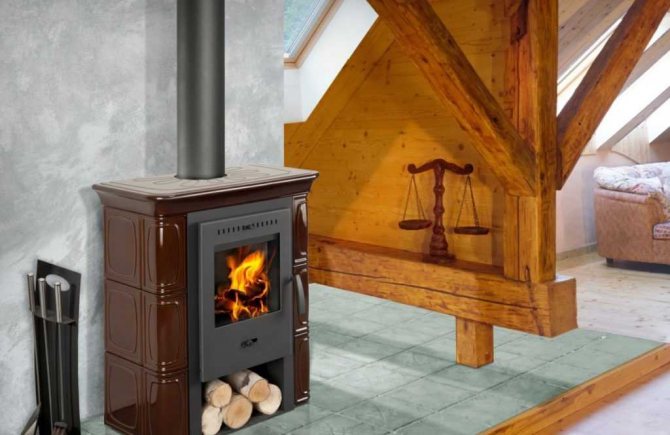
Small stove
There are three ways to place a stove in a house where there is only one room and there is not a single wall, even separating the kitchen or hallway.
- If the room is not very large, the fact that free space comes to the fore. A stove, even the smallest one, if placed in the middle, will steal a lot of it. In this case, the heat output will be maximum, there is nothing to say here, but constantly cruising around it is not entirely convenient. This option is suitable only with a spacious room.
- If you place the stove against the wall, there will be more free space. But, you say, in this case one working surface of the wall will work idle, directly heating the wall near which it is located. This is true, and in this case the wall must be protected from overheating using thermal insulation materials. Or place the stove so that there is a small gap between it and the wall, at least 15 centimeters wide. And the wall will be safe, and the warm air circulating in this opening will also work to heat the entire room.
- In very small houses, a stove of a special design is placed in the corner, observing all safety measures. Usually two work surfaces are enough to heat the entire room.
However, we must not forget that real skilled stove makers can even make a small stove in such a way that it can accommodate a stove, an oven and other auxiliary devices. Well, if used correctly, it will heat no worse than a real Russian village stove.
Basic malfunctions and ways to eliminate them
The most typical malfunctions of the VAZ 2107 stove include:
- Air entering the cooling system. This usually happens after the system has been filled with antifreeze. Removing the airlock normalizes the heating process of the interior.
- When the heater tap is open, coolant does not flow into the radiator. This most often occurs when water is used as antifreeze. Scale forms in the system, clogging the faucet and impeding the passage of coolant. The problem is eliminated by dismantling the tap and then cleaning or replacing it.
- Poorly functioning or failed water pump. If the pump does not pump coolant, this can lead not only to a lack of heating of the interior, but also to more serious problems, such as engine overheating. The water pump does not work, as a rule, when the generator belt breaks, as well as when it jams as a result of wear on the bearings.
- Clogged stove radiator honeycomb. In this case, the supply pipe will be warm and the outgoing pipe will be cold. The radiator often becomes clogged when water is used as a coolant, as well as when oil or additive particles enter the system to eliminate leaks. Cleaning or replacing the radiator will help restore normal operation of the stove.
- Displacement of the partition in the radiator. If both radiator hoses are hot, but warm air does not enter the cabin, then most likely the partition in the radiator has shifted. The only solution to the problem is to replace the radiator with a new one.
Heating a multi-room house
One-room houses can now only be found in collective gardens, where the size of the garden is much more important than one’s own amenities. And in winter, the owners rarely come there, and the house usually remains unheated from autumn to spring. By and large, this is not required, so a small stove is enough for them.
It’s another matter when the house has many rooms or even two or even three floors. There is no way to do without a well-thought-out heating system. And if, in order to heat the second and especially the third floor, you have to design and install an entire heating system, for example water or air, then in a one-story house you can get by with one, correctly located stove.
And here you have to dance... not from the stove. And on the number and location of rooms and interior partitions.
As already mentioned, the location of the Russian stove must be calculated at the design stage of the entire structure. And don’t just point your finger at the plan of the future house, but think carefully about where the hallway, kitchen, bedroom, and so on will be. This will determine not only where the stove will stand, but also in which direction it will be turned, which means the stove maker will be able to fold it in the most optimal way, laying the chimney so that it heats the necessary surfaces, and the cleaning holes do not go above the bed .
- Two rooms. To heat them evenly, the stove must be built into the interior partition so that the working surface of the stove is in the first room, and the second in the second. Make the firebox in the room closest to the exit.
- Three rooms. In this case, you will really have to dance from the stove. It should be located approximately in the middle of the entire building, and interior partitions should be attached to it so that the stove is evenly divided between all three rooms. A larger exception can be made in favor of the kitchen.
- Four rooms. And this option is quite possible. The principle is the same as in a three-room house, only the stove will have to be divided into four parts. And this is as easy as shelling pears. The Russian stove is usually four-sided, so there shouldn’t be any big problems.
- Stove with fireplace. This option requires more skill from the stove maker than from the designer. It is he who must fold the stove in such a way that in one room there is a regular firebox and, if necessary, a stove. But into the second fireplace hearth. The difficulty is that the fireplace has an open firebox and a direct chimney is needed to create draft, otherwise the fireplace will smoke into the room.
In even more spacious houses, or in those where there are only two, but huge rooms, a single stove may not cope. And then you will have to install an assistant for her, or make a heating system.
Causes of heating system malfunction
Experts identify several reasons why normal circulation of antifreeze is impossible:
- Coolant leak. It can occur as a result of natural wear and tear of parts of the cooling system, damage to the unit by corrosion or a hard object. In this case, it is necessary to replace the radiator or other damaged parts of the system. A malfunction in the stove shows itself as antifreeze leaking into the cabin, under the feet of the front passenger or driver.
- Obstruction of the internal tubes of the heat exchanger. This is evidenced by the impossibility of adjusting the air supply - only a cold or exceptionally warm stream will blow into the cabin. In this case, it is possible to get by by washing and purging the unit.
Many car problems occur with the arrival of cold weather, and this especially applies to cars from the domestic auto industry. One of the main problems is the inefficient operation of the heating system, as a result of which the windshield and side windows are poorly heated. VAZ 2107 owners quite often encounter a situation where in winter the car’s interior simply does not warm up.
The main elements of the VAZ 2107 stove are:
- radiator;
- tap;
- fan;
- control cables;
- air ducts
Parts of the heater and body ventilation of the VAZ 2107: 1 — lever of the air distribution cover; 2 — bracket for control levers; 3 — handles of heater control levers; 4 — air duct for heating the side window; 5 - flexible rods; 6 - heating air duct
As the vehicle is used, certain malfunctions may occur with the stove, which reduce the efficiency of the unit or make its operation completely impossible. There are not many signs of major problems and they boil down to the following:
- heater leak;
- lack of heat or weak air heating.
As for the service life of the stove, it is inappropriate to give any figures. It all depends on the quality of the parts, the coolant used, as well as the frequency of operation of the car.
Radiator leak
If the heat exchanger is leaking, it won’t be difficult to detect. Coolant in the form of a puddle will be under the feet of the driver or passengers. However, you should not rush to conclusions and buy a new radiator to replace it. The leak may be associated not only with it, but also with leaky pipes or faucets.
To do this, you need to get close to these elements and carefully examine them with good lighting. Having made sure that the problem is not in them, only the radiator remains. By the way, sometimes when a leak appears while the heater fan is running, the windshield fogs up and a characteristic smell of antifreeze appears. Having found out that the reason lies in the heat exchanger, it will need to be removed and then repaired or replaced with a new one.
If a radiator leaks, the part needs to be repaired or replaced.
The stove doesn't heat
If the engine is warm, the heater valve is open, but cold air is coming from the heating system, then most likely the radiator is clogged or there is a low level of antifreeze in the cooling system. To check the coolant level, just look at the level in the expansion tank or unscrew the main radiator cap with the engine off.
If there are no problems with the level, then you need to deal with the heat exchanger, you may have to flush it or the entire cooling system. To avoid possible clogging of the heater radiator, you should not add various additives that eliminate small leaks. Such products can easily clog the stove tubes.
Cold air flow from the heating system can also be caused by air in the system. In this case, you will need to remove the air plug and add coolant.
The heater tap may fail over time as a result of scale formation.
In addition, the problem is possible with the tap itself, which over time can become clogged or scale may form if water is used instead of antifreeze. If there is a problem with the tap, the part is disassembled and cleaned or simply replaced. Another, although rare, but possible cause of a cold stove, may be pump failure.
In this case, the engine warms up, but the pipes going to the heater radiator remain cold. In this case, the water pump must be repaired immediately. Warm air may also not enter the cabin due to problems with the heater fan. The problem may be with the motor itself or its power circuit, for example, if a fuse blows.
Iron stove in the house
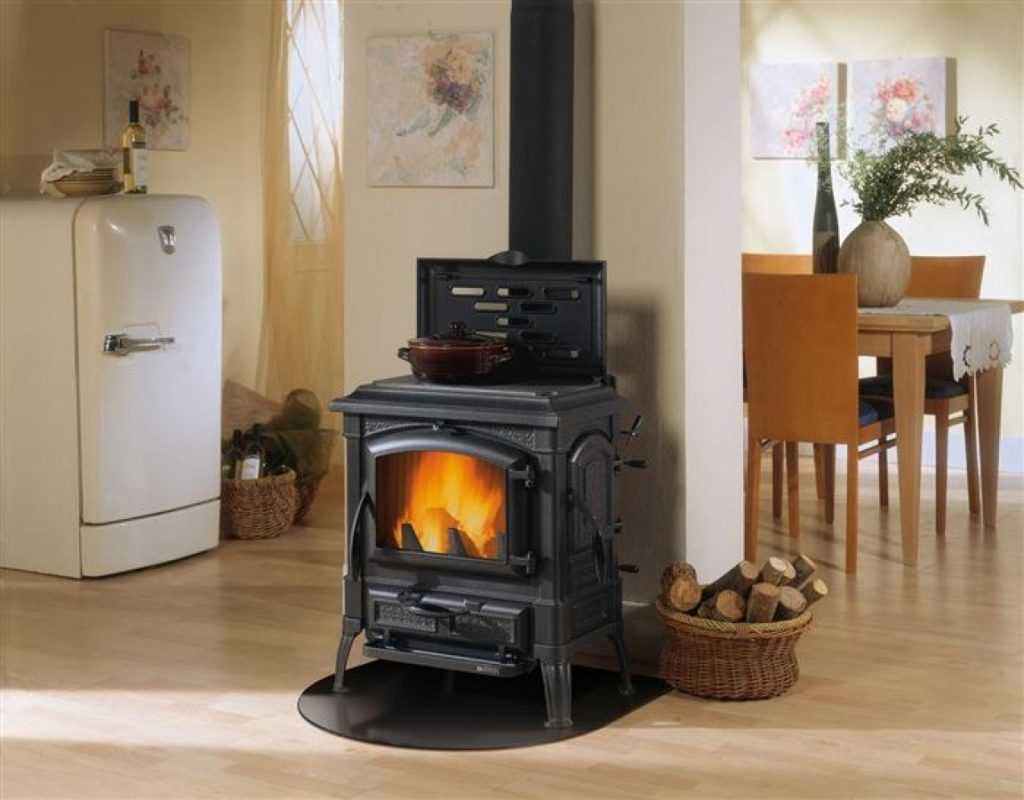
Iron stove
Sweet, kind, blazing hot, red-hot “potbelly stove”. True, modern stylish versions of iron wood-burning stoves no longer fit this name, but its functions have not changed.
Installing an iron stove in a house is much easier than building a brick one, however, its safety requirements are somewhat higher.
- Fire safety. The temperature of the walls of an iron wood-burning stove is several times higher than that of a brick stove. Therefore, care must be taken when handling it.
- It is also necessary to protect the floor and walls near which it is installed from overheating.
- The installation location is calculated taking into account the location of windows and doors in the room. But no closer than 50 cm from the wall, even if it is impregnated with a fire retardant substance and finished with non-flammable materials.
- It is also necessary to equip a place around the stove where firewood, tools and other elements necessary for proper operation will be stored.
Of course, such a stove alone cannot heat a multi-room house, which is why it is used in most cases in small or temporary houses. Although, if you install it in a utility room and connect it to a water heating system, then even a two-story house will be warm.
Fire protection
Another most important question that you should think carefully about at the same time as how to determine the correct location of the stove in a wooden house is how to protect it from fire. Proper and careful handling of heating appliances is not always enough.
Fire is an unpredictable and difficult to control element. And if by some chance he broke free, then it is very difficult to stop him. That is why you should initially consider security measures.
- Firstly, this issue should also be addressed at the design stage. Different types of wood used in the construction of residential buildings have different flammability classes. Naturally, you need to choose the safest one.
- In addition, walls, especially in the immediate vicinity of the stove, can be treated with special substances. So-called fire retardants are not expensive, but they can bring a lot of benefits. It must be said right away that they will not make the wall completely impervious to fire. But they will significantly reduce the flammability threshold and slow down the combustion process itself.
- It would be a good idea to cover the walls and floor near the stove with special fire-resistant finishing materials. Asbestos, cement or gypsum plaster, facing brick are great for this purpose, turning the stove area not only into a safe, but also a beautiful space.
- But the use of vinyl and polymer finishing materials in these places is not only not recommended, but is also considered dangerous. They have the very unpleasant property of releasing very toxic chemicals when burned, which leads to severe poisoning and even death.
Signs of a malfunction of the VAZ 2107 heater radiator
A malfunction of the VAZ 2107 heater radiator manifests itself in two variants:
- The radiator is leaking.
- The stove doesn't heat.
If you unexpectedly find a puddle of coolant under the feet of the driver or passenger, then there is a high probability that the heater radiator will need to be replaced. There is no need to rush to change it immediately after detecting antifreeze in the cabin. First you need to make sure that it is the radiator that is leaking, and not the heater pipe or tap.
By the way, a leak may not appear in the form of a puddle of antifreeze under your feet. Sometimes the leak is not very large and the hot antifreeze flowing from the heater radiator evaporates under the influence of the air flow from the heater fan. In this case, the windows begin to fog up while the stove is operating. The cause of the leak may be corrosion of the radiator material or damage due to physical impact. To eliminate the leak, the radiator must be removed and then either soldered or replaced with a new one.
If, when the engine is warm and the heater tap is open, cold or barely warm air comes from the heater, the reason is a clogged heater core. Most often, the radiator becomes clogged when the car owner tries to fix a leak in the engine cooling system by adding various “miracle additives” to the antifreeze, designed to combat small coolant leaks.

Yes, such additives can clog a leak, but they also clog thin radiator tubes. The radiator can also become clogged due to rust or poor-quality coolant. In this case, it is useless to try to pour in other additives designed to clean the cooling system. The radiator must be removed and tried to be washed or replaced.
Russian stove with stove bench
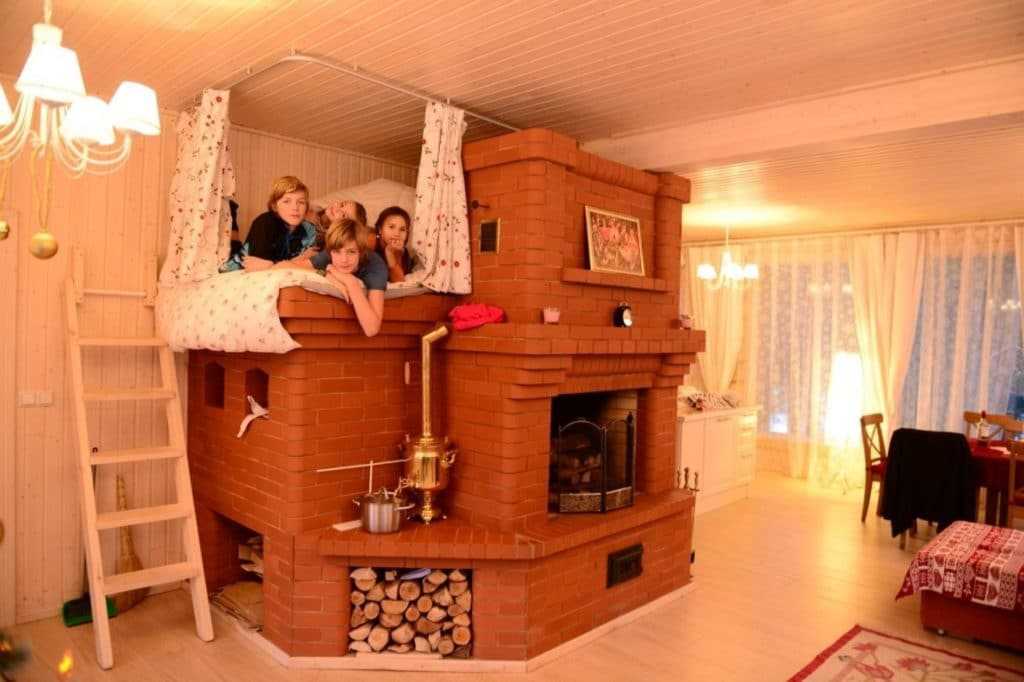
Russian stove with stove bench
For a wooden multi-room house, this is perhaps the best option, although it is becoming less and less common. Firstly, because there are fewer and fewer skilled stove makers who can correctly build such a stove. And secondly, it simply went out of fashion, but in vain.
The design features of a real Russian stove are not only that it is capable of heating a fairly large multi-room house. With the correct location and high-quality performance, such a stove is much more economical. The internal chimneys are designed in such a way that they heat not only the main body of the stove, but also the stove bench, which can be taken out into any room if desired, and the dryer. It takes quite a long time to cool down, and a very small amount of firewood is required for daily heating.
Well, there is no escape from such an element as a kitchen stove, on which you must be able to cook, but if you master this ancient art, then the whole house will be filled with amazing aromas. It’s not without reason that they say that pies, porridge and borscht are the most delicious from the Russian oven.
Let's sum it up
So, there are not so many options for the correct location of a brick or iron wood-burning stove. They depend on the layout of the house and the design of the stove itself. It is necessary to choose a location at the design stage and it is better to have a real specialist do this, who can calculate both the heat loss of the house and the heat transfer of the furnace located in one place or another.
But no matter what option you choose, wall-mounted, corner, in an interior partition, with a hob or fireplace, fire safety measures should not be neglected under any circumstances.
And then your home will be warm, cozy, fun and festive, no matter what bad weather is raging outside the window.


